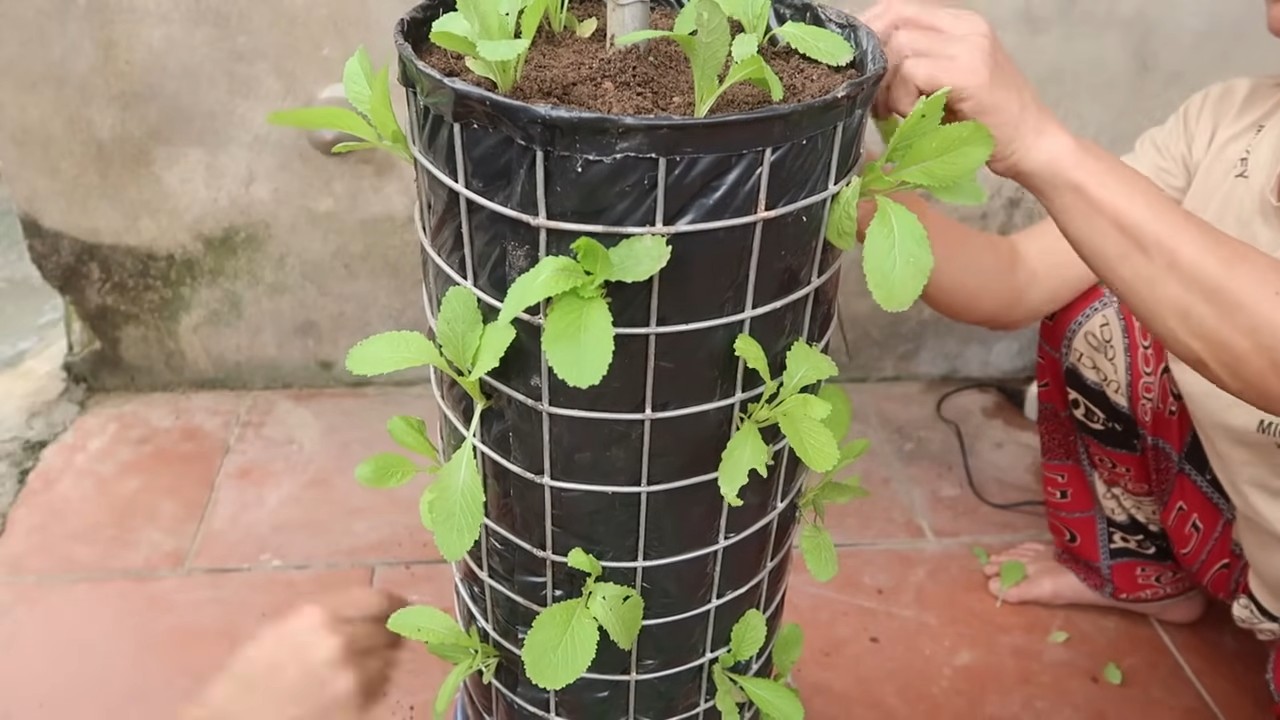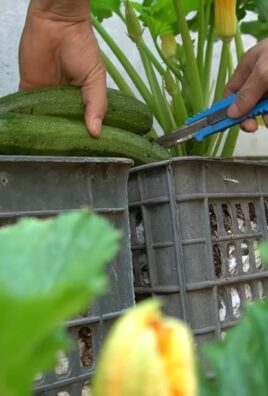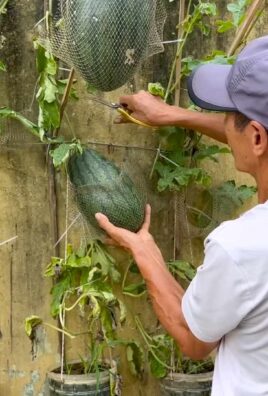DIY Vertical Veggie Garden: Imagine stepping outside your door and harvesting fresh, flavorful vegetables, even if you only have a tiny balcony or patio! For centuries, humans have cultivated food in limited spaces, from the hanging gardens of Babylon to the ingenious terrace farming techniques of ancient civilizations. But you don’t need to be an ancient engineer to create your own edible oasis.
In today’s world, where space is a premium and access to fresh, healthy produce can be challenging, a DIY Vertical Veggie Garden is more than just a trend – it’s a practical solution. I’m excited to share some simple, yet effective, DIY tricks and hacks that will transform your small space into a thriving vertical garden.
Whether you’re a seasoned gardener or a complete beginner, this guide will provide you with the knowledge and inspiration to build your own vertical veggie garden. We’ll explore different methods, materials, and plant choices, ensuring you have all the tools you need to create a beautiful and productive garden that fits your unique style and needs. So, let’s get our hands dirty and start building your dream vertical veggie garden today!

DIY Vertikaler Gemüsegarten: Dein eigener grüner Daumen auf kleinstem Raum
Hey Gartenfreunde! Habt ihr auch so wenig Platz, aber trotzdem Lust auf frische, selbst angebaute Kräuter und Gemüse? Dann habe ich genau das Richtige für euch: einen vertikalen Gemüsegarten! Das ist nicht nur super platzsparend, sondern sieht auch noch richtig schick aus. Ich zeige euch, wie ihr das ganz einfach selber bauen könnt. Los geht’s!
Was du brauchst: Die Materialliste
Bevor wir loslegen, hier eine Liste mit allen Materialien und Werkzeugen, die du für deinen vertikalen Garten brauchst:
* Holzpaletten: Am besten gebrauchte Europaletten (EPAL). Achte darauf, dass sie unbehandelt und sauber sind. Du kannst sie oft kostenlos oder sehr günstig bekommen.
* Geotextil oder Teichfolie: Zum Auskleiden der Pflanzkästen. Das verhindert, dass die Erde herausrieselt und schützt das Holz vor Feuchtigkeit.
* Tacker und Tackerklammern: Zum Befestigen des Geotextils.
* Schleifpapier: Um raue Stellen an der Palette zu glätten und Splitter zu entfernen.
* Holzschutzlasur oder -farbe (optional): Um die Palette vor Witterungseinflüssen zu schützen und ihr einen schönen Look zu verleihen.
* Erde: Hochwertige Pflanzerde ist das A und O für gesundes Wachstum.
* Pflanzen: Kräuter, Salat, Erdbeeren, kleine Gemüsesorten – was dein Herz begehrt!
* Handschuhe: Zum Schutz deiner Hände.
* Schere oder Cuttermesser: Zum Zuschneiden des Geotextils.
* Maßband oder Zollstock: Zum Ausmessen.
* Bohrmaschine und Schrauben (optional): Falls du zusätzliche Verstärkungen anbringen möchtest.
* Pinsel oder Rolle (optional): Zum Auftragen der Lasur oder Farbe.
Schritt-für-Schritt-Anleitung: So baust du deinen vertikalen Garten
Jetzt geht’s ans Eingemachte! Folge diesen Schritten, um deinen eigenen vertikalen Gemüsegarten zu bauen:
1. Palette vorbereiten:
* Zuerst solltest du die Palette gründlich reinigen. Entferne Schmutz, Staub und eventuelle lose Teile.
* Schleife die Oberfläche der Palette mit Schleifpapier ab. Achte besonders auf raue Stellen und Splitter, um Verletzungen zu vermeiden.
* Wenn du möchtest, kannst du die Palette jetzt mit Holzschutzlasur oder -farbe behandeln. Das schützt das Holz vor Witterungseinflüssen und verleiht ihm einen schönen Look. Lass die Lasur oder Farbe gut trocknen, bevor du weitermachst. Ich persönlich mag es, wenn die Palette ihren natürlichen Look behält, aber das ist natürlich Geschmackssache.
2. Pflanzkästen auskleiden:
* Messe die Innenmaße der Fächer in der Palette aus, die du als Pflanzkästen nutzen möchtest.
* Schneide das Geotextil oder die Teichfolie entsprechend zu. Achte darauf, dass du genügend Material hast, um die Kästen komplett auszukleiden und einen kleinen Rand zu bilden.
* Lege das Geotextil oder die Teichfolie in die Fächer und fixiere es mit dem Tacker an den Innenseiten der Palette. Achte darauf, dass die Klammern gut sitzen und das Material fest verankert ist. So verhinderst du, dass die Erde später herausrieselt.
3. Erde einfüllen:
* Fülle die ausgekleideten Pflanzkästen mit hochwertiger Pflanzerde. Achte darauf, dass die Erde locker und luftig ist, damit die Wurzeln der Pflanzen gut wachsen können.
* Lass oben einen kleinen Rand frei, damit die Erde beim Gießen nicht überschwappt.
4. Pflanzen einsetzen:
* Jetzt kommt der schönste Teil: das Bepflanzen! Wähle Pflanzen, die für den Anbau in Töpfen und Kästen geeignet sind. Kräuter wie Basilikum, Petersilie, Schnittlauch oder Thymian sind eine gute Wahl. Auch Salat, Erdbeeren oder kleine Gemüsesorten wie Radieschen oder Mini-Paprika eignen sich gut.
* Setze die Pflanzen vorsichtig in die Erde und drücke sie leicht an. Achte darauf, dass die Wurzeln genügend Platz haben.
* Gieße die Pflanzen nach dem Einsetzen gründlich an.
5. Vertikalen Garten aufstellen:
* Suche einen geeigneten Standort für deinen vertikalen Garten. Er sollte hell genug sein, aber nicht unbedingt in der prallen Mittagssonne stehen.
* Stelle die Palette aufrecht hin. Du kannst sie an einer Wand anlehnen oder mit zusätzlichen Stützen stabilisieren.
* Achte darauf, dass der Standort gut zugänglich ist, damit du die Pflanzen regelmäßig gießen und pflegen kannst.
Zusätzliche Tipps und Tricks für deinen vertikalen Garten
Hier noch ein paar zusätzliche Tipps, die dir helfen werden, deinen vertikalen Garten optimal zu nutzen:
* Bewässerung: Achte darauf, dass die Erde in den Pflanzkästen immer leicht feucht ist. Gieße regelmäßig, aber vermeide Staunässe. Eine automatische Bewässerung kann dir viel Arbeit ersparen.
* Düngung: Dünge deine Pflanzen regelmäßig mit einem organischen Dünger, um sie mit ausreichend Nährstoffen zu versorgen.
* Schutz vor Schädlingen: Kontrolliere deine Pflanzen regelmäßig auf Schädlinge und bekämpfe sie bei Bedarf mit natürlichen Mitteln.
* Sonneneinstrahlung: Achte darauf, dass deine Pflanzen genügend Sonnenlicht bekommen. Je nach Standort kann es sinnvoll sein, die Palette regelmäßig zu drehen.
* Pflanzenauswahl: Wähle Pflanzen, die gut miteinander harmonieren und ähnliche Ansprüche an Licht, Wasser und Nährstoffe haben.
* Kreativität: Sei kreativ bei der Gestaltung deines vertikalen Gartens! Du kannst die Palette mit zusätzlichen Elementen wie Rankgittern oder kleinen Regalen verschönern.
Häufige Fehler vermeiden: Darauf solltest du achten
Damit dein vertikaler Garten ein voller Erfolg wird, solltest du diese häufigen Fehler vermeiden:
* Falsche Palette: Verwende nur unbehandelte Europaletten (EPAL). Behandelte Paletten können Schadstoffe enthalten, die in die Erde und somit in deine Pflanzen gelangen.
* Schlechte Erde: Spare nicht an der Erde! Hochwertige Pflanzerde ist das A und O für gesundes Wachstum.
* Falsche Pflanzen: Wähle Pflanzen, die für den Anbau in Töpfen und Kästen geeignet sind und ähnliche Ansprüche haben.
* Überwässerung: Vermeide Staunässe! Das kann zu Wurzelfäule führen.
* Vernachlässigung: Ein vertikaler Garten braucht regelmäßige Pflege. Gieße, dünge und kontrolliere deine Pflanzen regelmäßig.
Fazit: Dein eigener vertikaler Garten ist zum Greifen nah!
Ich hoffe, diese Anleitung hat dir geholfen, deinen eigenen vertikalen Gemüsegarten zu bauen. Es ist wirklich einfacher als es aussieht und macht unglaublich viel Spaß! Und das Beste daran: Du hast immer frische Kräuter und Gemüse direkt vor der Haustür. Also, worauf wartest du noch? Ran an die Paletten und losgelegt! Viel Spaß beim Gärtnern!

Conclusion
So, there you have it! Creating your own DIY Vertical Veggie Garden is not just a fun weekend project; it’s a game-changer for anyone looking to maximize their space, enjoy fresh, homegrown produce, and add a touch of green to their surroundings. We’ve walked you through the process, highlighting the ease and affordability of building your own vertical garden.
But why is this a must-try? Beyond the obvious benefits of fresh vegetables at your fingertips, a vertical garden offers a unique blend of practicality and aesthetics. It’s a space-saving solution for apartment dwellers, balcony gardeners, and anyone with limited yard space. Imagine stepping outside your kitchen and snipping fresh herbs for your dinner, or harvesting ripe tomatoes for a salad, all grown just inches away. The satisfaction of nurturing your own food from seed to table is incredibly rewarding.
Furthermore, a vertical garden is a fantastic way to reduce your carbon footprint. By growing your own produce, you’re minimizing the need for transportation and packaging, contributing to a more sustainable lifestyle. Plus, it’s a great conversation starter! Your friends and neighbors will be amazed by your ingenuity and the beauty of your vertical oasis.
Don’t be afraid to get creative with your DIY Vertical Veggie Garden! Consider these variations to personalize your project:
* Herb Heaven: Dedicate a vertical garden specifically to herbs like basil, mint, rosemary, and thyme. This is perfect for adding fresh flavors to your cooking.
* Strawberry Sensation: Strawberries thrive in vertical gardens, cascading beautifully and providing a sweet treat throughout the growing season.
* Salad Bar: Grow a variety of leafy greens like lettuce, spinach, and kale for a constant supply of fresh salad ingredients.
* Repurposed Pallet Garden: Transform an old wooden pallet into a rustic and charming vertical garden.
* Hanging Gutter Garden: Use repurposed gutters to create a unique and visually appealing vertical garden system.
Remember to choose plants that are well-suited to your climate and the amount of sunlight your vertical garden receives. Proper watering and fertilization are also crucial for healthy growth.
We are confident that you’ll find this project both enjoyable and rewarding. The benefits of having fresh, homegrown vegetables are undeniable, and the process of creating your own vertical garden is a fun and fulfilling experience.
So, what are you waiting for? Gather your materials, follow our instructions, and embark on your DIY Vertical Veggie Garden adventure today! We can’t wait to see what you create. Share your photos and experiences with us in the comments below or on social media using #DIYVerticalVeggieGarden. Let’s inspire others to embrace the joys of homegrown goodness! We are eager to hear about your successes, challenges, and creative adaptations. Your feedback will help us improve our guide and inspire other gardeners to embark on their own vertical gardening journeys. Happy gardening!
Frequently Asked Questions (FAQ)
What are the best vegetables to grow in a DIY Vertical Veggie Garden?
The best vegetables for a vertical garden are generally those with shallow root systems and compact growth habits. Some excellent choices include:
* Leafy Greens: Lettuce, spinach, kale, and arugula thrive in vertical gardens and are easy to harvest.
* Herbs: Basil, mint, rosemary, thyme, oregano, and parsley are all well-suited for vertical growing.
* Strawberries: These cascading plants are both beautiful and productive in vertical gardens.
* Tomatoes (Determinate Varieties): Choose bush or dwarf tomato varieties that don’t require extensive staking.
* Peppers (Smaller Varieties): Bell peppers, chili peppers, and other smaller pepper varieties can be grown successfully.
* Radishes: These fast-growing root vegetables are a great option for quick harvests.
* Bush Beans: Compact bush bean varieties are easier to manage in a vertical garden than pole beans.
* Edible Flowers: Nasturtiums, pansies, and calendula add beauty and flavor to your garden.
Consider the amount of sunlight your vertical garden receives and choose plants accordingly. Leafy greens and herbs generally tolerate partial shade, while tomatoes and peppers need at least 6-8 hours of sunlight per day.
How do I water a DIY Vertical Veggie Garden?
Watering is crucial for the success of your vertical garden. Here are some tips:
* Water Regularly: Vertical gardens tend to dry out faster than traditional gardens, so check the soil moisture daily.
* Water Thoroughly: Water until the water drains out of the bottom of the containers. This ensures that the roots are adequately hydrated.
* Use a Watering Can or Hose with a Gentle Spray: Avoid blasting the plants with a strong stream of water, which can damage delicate foliage.
* Consider a Drip Irrigation System: For larger vertical gardens, a drip irrigation system can automate watering and ensure consistent moisture levels.
* Water in the Morning: Watering in the morning allows the foliage to dry before nightfall, reducing the risk of fungal diseases.
* Adjust Watering Based on Weather: Water more frequently during hot, dry weather and less frequently during cool, rainy weather.
What type of soil should I use for my DIY Vertical Veggie Garden?
The ideal soil for a vertical garden is a well-draining potting mix that retains moisture. Avoid using garden soil, as it can be too heavy and compact in containers. Look for a potting mix that contains:
* Peat Moss or Coco Coir: These materials help retain moisture and provide aeration.
* Perlite or Vermiculite: These materials improve drainage and prevent the soil from becoming compacted.
* Compost: Compost adds nutrients and improves soil structure.
You can also create your own potting mix by combining equal parts peat moss or coco coir, perlite or vermiculite, and compost. Consider adding a slow-release fertilizer to provide essential nutrients to your plants.
How do I fertilize my DIY Vertical Veggie Garden?
Vertical gardens require regular fertilization to provide the nutrients that plants need to thrive. Here are some options:
* Slow-Release Fertilizer: Incorporate a slow-release fertilizer into the potting mix at planting time. This will provide a steady supply of nutrients over several months.
* Liquid Fertilizer: Use a liquid fertilizer every 2-4 weeks during the growing season. Follow the instructions on the fertilizer label.
* Compost Tea: Compost tea is a natural fertilizer that provides essential nutrients and beneficial microbes to the soil.
* Organic Fertilizers: Consider using organic fertilizers like fish emulsion or seaweed extract.
Avoid over-fertilizing, as this can damage plants. Always follow the instructions on the fertilizer label.
How do I protect my DIY Vertical Veggie Garden from pests and diseases?
Preventing pests and diseases is essential for a healthy vertical garden. Here are some tips:
* Choose Disease-Resistant Varieties: Select plant varieties that are known to be resistant to common diseases.
* Provide Good Air Circulation: Ensure that your vertical garden has good air circulation to prevent fungal diseases.
* Water Properly: Avoid overwatering, as this can create a favorable environment for fungal diseases.
* Inspect Plants Regularly: Check your plants regularly for signs of pests or diseases.
* Remove Infested Leaves: Remove any leaves that are infested with pests or diseases.
* Use Organic Pest Control Methods: Consider using organic pest control methods like insecticidal soap or neem oil.
* Attract Beneficial Insects: Plant flowers that attract beneficial insects like ladybugs and lacewings, which prey on pests.
How much sunlight does my DIY Vertical Veggie Garden need?
The amount of sunlight your vertical garden needs depends on the types of plants you are growing. In general:
* Vegetables that need full sun (6-8 hours of direct sunlight per day): Tomatoes, peppers, cucumbers, squash, and beans.
* Vegetables that tolerate partial shade (4-6 hours of direct sunlight per day): Leafy greens (lettuce, spinach, kale), herbs (parsley, cilantro), and radishes.
If your vertical garden doesn’t receive enough sunlight, you may need to supplement with artificial lighting. Grow lights can provide the necessary light for plants to thrive indoors or in shady areas.
Can I grow my DIY Vertical Veggie Garden indoors?
Yes, you can grow a vertical garden indoors, but you’ll need to provide adequate light and humidity. Choose plants that tolerate lower light levels, such as leafy greens and herbs. You may also need to supplement with grow lights.
To increase humidity, you can mist your plants regularly or place a tray of water near the vertical garden. Ensure that your indoor vertical garden has good air circulation to prevent fungal diseases.
How do I overwinter my DIY Vertical Veggie Garden?
If you live in a cold climate, you’ll need to take steps to overwinter your vertical garden. Here are some options:
* Bring Plants Indoors: Move your vertical garden indoors before the first frost. Provide adequate light and humidity.
* Protect Plants Outdoors: If you




Leave a Comment